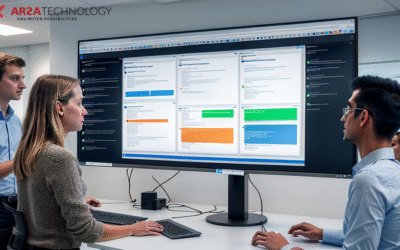Introduction: Overcoming Manual Student Attendance Tracking in the Education Industry
The digital transformation sweeping through the education sector promises enhanced learning experiences and streamlined administrative processes. Yet, a persistent challenge remains: manual student attendance tracking. This age-old practice, often reliant on paper registers or cumbersome manual input, is a significant drain on valuable teaching time, prone to errors, and a source of administrative inefficiency. Educators are diverted from their primary mission of teaching, and institutions face delays in data processing and reporting. The need for a robust, automated solution is more pressing than ever.
Imagine a world where attendance is effortlessly managed, freeing up educators to focus entirely on their students. This vision is now attainable through the strategic implementation of in-app voice guidance for mobile applications, powered by advanced AI. ARSA Technology’s Text-to-Speech API offers a powerful pathway to transform this critical administrative function, providing natural-sounding, multilingual voice synthesis that can be seamlessly integrated into educational mobile platforms. This article explores how developers can leverage this innovative technology to build intelligent, voice-guided attendance systems, addressing a core pain point and ushering in a new era of efficiency in education.
The Challenge of Manual Attendance in Modern Education
Traditional attendance methods, whether paper-based or requiring manual digital entry, are fraught with inefficiencies. Each minute spent calling out names or manually marking attendance is a minute taken away from instruction. This accumulates into significant lost teaching time over a semester, impacting curriculum delivery and student engagement. Beyond time consumption, manual processes are inherently susceptible to human error, leading to inaccurate records that can affect everything from funding allocations to student performance evaluations.
Furthermore, the administrative burden extends beyond the classroom. Support staff often spend countless hours compiling, verifying, and reporting attendance data, a task that is both tedious and resource-intensive. In an increasingly data-driven educational landscape, institutions require accurate, real-time attendance insights to identify at-risk students, track engagement, and comply with regulatory requirements. Manual systems simply cannot deliver this level of agility and precision, creating a bottleneck that hinders the overall operational efficiency and strategic decision-making within educational institutions.
Transforming Attendance with Intelligent Voice Guidance
The solution lies in harnessing the power of artificial intelligence to create intelligent, automated attendance systems. By integrating in-app voice guidance into mobile applications, educational institutions can transition from reactive, manual tracking to a proactive, automated approach. Imagine a mobile application that, upon a student’s entry into a virtual or physical classroom, automatically prompts them with a clear, natural-sounding voice to confirm their presence. This can be achieved through a simple voice command or a quick tap, significantly reducing the time and effort required for attendance.
This approach not only streamlines the process but also enhances accuracy. Voice guidance can be linked to location services, login events, or even facial recognition systems (if desired), ensuring that attendance is recorded precisely when and where it should be. For students, it offers a modern, intuitive, and less disruptive way to mark their presence. For educators, it means more time dedicated to teaching and less to administration, fostering a more engaging and productive learning environment. The shift towards voice-guided attendance represents a strategic move towards a more efficient, reliable, and future-proof educational infrastructure.
ARSA Technology’s Text-to-Speech API: Your Solution for Seamless Integration
At the heart of this transformative capability is ARSA Technology’s Text-to-Speech (TTS) API. Designed for high performance and ease of integration, our TTS API converts written text into lifelike spoken audio, making it the ideal tool for developing sophisticated in-app voice guidance systems. Developers can leverage this API to generate custom attendance prompts, instructions, and confirmations that are clear, consistent, and engaging for students.
The API offers a rich selection of voices, allowing institutions to choose tones and accents that resonate with their student body. Its advanced synthesis capabilities ensure that the generated speech is not robotic or monotonous but possesses the natural inflections and rhythm of human speech, crucial for effective communication in an educational context. Integrating this API means that any text-based information, from simple attendance questions to complex instructions, can be instantly vocalized within your mobile application. To see the API in action, try the Text-to-Speech API. This interactive demo provides a direct experience of its capabilities, showcasing how effortlessly text can be transformed into high-quality audio.
Key Features Driving Educational Innovation
ARSA Technology’s Text-to-Speech API is built with features that directly address the needs of the modern education sector:
- Naturalness and Clarity: The API produces highly natural and intelligible speech, ensuring that voice guidance is easily understood by all students, regardless of their background. Clear pronunciation and appropriate pacing are vital for effective instruction and engagement.
- Multilingual Support: In today’s diverse educational environments, multilingual support is non-negotiable. Our TTS API supports a wide array of languages and dialects, enabling institutions to provide voice guidance in students’ native tongues, fostering inclusivity and better comprehension.
- Scalability and Reliability: Built for enterprise-grade performance, the API can handle high volumes of requests, ensuring that attendance systems remain responsive and reliable even during peak times in large institutions. Its robust infrastructure guarantees consistent performance.
- Customization Options: Developers have control over various speech parameters, including voice selection, speaking rate, and pitch. This allows for the creation of tailored voice experiences that match the specific branding and pedagogical approach of an educational institution.
- Ease of Integration: While powerful, the API is designed for straightforward integration into existing mobile applications and learning management systems. This minimizes development time and resources, allowing institutions to rapidly deploy voice-guided solutions.
Practical Implementation: Designing Your Voice-Guided Attendance System
Implementing a voice-guided attendance system using ARSA Technology’s Text-to-Speech API involves a conceptual yet strategic approach for developers. The process begins with identifying the specific textual prompts required for attendance confirmation. For example, “Welcome to today’s lecture. Please confirm your presence by tapping the ‘Present’ button,” or “Attendance for this session is now open. State ‘present’ to mark your attendance.”
Developers would then integrate the Text-to-Speech API into their mobile application’s backend or frontend logic. When a specific event occurs – such as a student logging into a class, entering a geofenced area, or at a scheduled time – the application sends the predefined attendance text to the ARSA TTS API. The API processes this text and returns high-quality audio, which the mobile application then plays to the student. This seamless interaction provides an intuitive and efficient way to gather attendance data. The data collected can then be automatically logged into a central database, eliminating manual entry and reducing errors. For more advanced solutions, developers might consider how this integrates with our full suite of AI APIs, potentially combining TTS with other AI capabilities for even richer educational experiences.
Beyond Attendance: Expanding Voice Guidance in Education
While automating attendance is a significant step, the potential of ARSA Technology’s Text-to-Speech API in education extends far beyond. Consider its application in:
- Accessibility Features: Providing voice narration for visually impaired students, making digital learning materials more accessible and inclusive.
- Language Learning: Offering accurate pronunciation guides for language learners, allowing them to hear words and phrases spoken correctly, enhancing their linguistic development.
- Interactive Learning: Creating dynamic, voice-guided quizzes and interactive lessons that provide immediate verbal feedback, making learning more engaging and personalized.
- Automated Announcements and Reminders: Delivering timely, clear voice announcements within the app for deadlines, events, or important updates, ensuring students are always informed.
By leveraging the versatility of the Text-to-Speech API, educational institutions can build comprehensive, voice-enabled learning environments that cater to diverse needs and enhance the overall educational experience.
The Business Impact: ROI and Competitive Advantage
The adoption of ARSA Technology’s Text-to-Speech API for in-app voice guidance in education translates directly into tangible business benefits and a significant return on investment (ROI). By automating manual student attendance tracking, institutions can expect:
- Significant Time Savings: Freeing up educators and administrative staff from tedious manual tasks, allowing them to focus on core educational and strategic initiatives.
- Improved Data Accuracy: Reducing human error in attendance records leads to more reliable data for reporting, compliance, and student support.
- Cost Reduction: Minimizing the labor hours associated with manual attendance processes and data management.
- Enhanced Student Experience: Providing a modern, intuitive, and accessible way for students to interact with their educational platform, leading to higher satisfaction.
- Competitive Differentiation: Positioning the institution as an innovator, leveraging cutting-edge AI to improve operational efficiency and student services, attracting both students and top faculty.
These benefits collectively contribute to a more efficient, engaging, and forward-thinking educational environment, providing a clear competitive advantage in a rapidly evolving sector.
Conclusion: Your Next Step Towards a Solution
Manual student attendance tracking is an outdated practice that no longer serves the dynamic needs of modern education. ARSA Technology’s Text-to-Speech API offers a powerful, elegant solution, enabling developers to integrate natural-sounding, multilingual voice guidance into mobile applications. This not only automates and refines the attendance process but also unlocks a myriad of possibilities for enhancing accessibility, engagement, and overall operational efficiency within educational institutions. By embracing this technology, you can transform a significant administrative burden into a seamless, intelligent, and value-adding component of your educational ecosystem. Should you have any questions or require tailored solutions, do not hesitate to contact our developer support team.
Ready to Build with ARSA Technology?
Start integrating our powerful APIs today. Get your free API key, explore the interactive documentation, and see how quickly you can bring your project to life.







